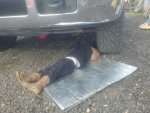- 445
- 862
- 93
- Location
- Orygun
So, I was thinking ...
Possibly a minty feller could undo the main feed line from the master, apply an air hose with air pressure, open the bleeders, or better yet just remove them, and blow out all of anything that is in the system except for air itself .
Do the rear section seperate from the front, even if it takes 20 min, who cares ?
You start fresh .
Maybe even blast some brake clean in there and let that blow thru to clean and dry the brake lines and wheel cylinders out nicely .
Then install DOT 3 .
I was told and convinced by everything I read that these military trucks had to have DOT 5, but now knowing more than I did then, I would have never flushed out and put in the DOT 5
Thoughts on that technique ?
How much pressure exists in those wheel cylinders when the brake pedal is hammered down at speed with a load on ?
I wouldn't think that a measly 120psi from my compressor divided between 2 or 4 wheel cylinders with open bleeders could possibly hurt anything .
And my Grandson concurs .

Possibly a minty feller could undo the main feed line from the master, apply an air hose with air pressure, open the bleeders, or better yet just remove them, and blow out all of anything that is in the system except for air itself .
Do the rear section seperate from the front, even if it takes 20 min, who cares ?
You start fresh .
Maybe even blast some brake clean in there and let that blow thru to clean and dry the brake lines and wheel cylinders out nicely .
Then install DOT 3 .
I was told and convinced by everything I read that these military trucks had to have DOT 5, but now knowing more than I did then, I would have never flushed out and put in the DOT 5
Thoughts on that technique ?
How much pressure exists in those wheel cylinders when the brake pedal is hammered down at speed with a load on ?
I wouldn't think that a measly 120psi from my compressor divided between 2 or 4 wheel cylinders with open bleeders could possibly hurt anything .
And my Grandson concurs .



